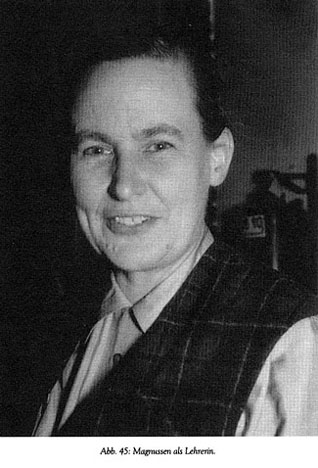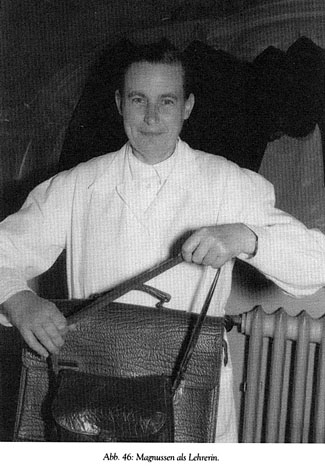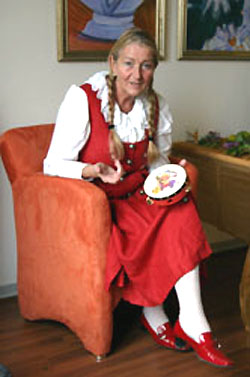
|

|

|

|
Karin Magnussen (February 9, 1908- February 19, 1997) was a researcher at the Kaiser Wilhelm Institute of Anthropology, Human Heredity, and Eugenics during Germany's Third Reich, known for her 1936 publication "Race and Population Policy Tools", and her studies of heterochromia iridis (different colored eyes) using iris specimens from Auschwitz concentration camp victims (supplied by Joseph Mengele).1, 2
Magnussen joined the National Socialist German Students' League (NSDStB) while she was still an undergraduate in college; by 1931 (when she was 23) she was a member of the National Socialist German Workers (Nazi) Party. Later she became a leader of the League of German Girls (Bänd Deutscher Mädel, or BDM), and a member of the National Socialist Teachers League. As a BDM leader, she held talks about the politics of race and population.
Magnussen may have modeled herself after "...the biologist Agnes Bluhm (worked at the Kaiser-Wilhelm-Institut fur Biologie) who wrote Die rassenhygienischen Aufgaben des weiblichen Arztes, Berlin, 1934, who unhesitatingly supported Hitler's regime."3
In 1935 Magnussen went to work in the Nazi Racial Policy Office in the District of Hanover. A year later, she authored "Implements of race and population policies". In the third edition of this volume (published in 1943), Magnussen expressed herself thus:
"This war is not only about the preservation of the German people, but the question of which races and peoples should live in the future Europe. ... The present war must therefore not only resolve the suppression of the Black Danger in the West and the removal of the Bolshevist threat in the East, but also a core problem of race in Europe, which concerns all States: The Jewish Question. The Jew, who still enjoys hospitality in our country, is our enemy even as he does not engage actively with weapons in the battle. ...From the European viewpoint, the Jewish Question is not solved by the emigration of the Jews from racially thinking states to other states. We have seen that these emigrants only create unrest and incite the other people against each other."4
Magnussen left Hanover District to work at the Kaiser Wilhelm Institute for Anthropology, Human Heredity, and Eugenics (KWI-A) in Dahlem, Berlin. Her value to the KWI-A was in her party connections and her credentials as a biologist. (Her training had been in zoology.) It was originally intended that Magnussen become the assistant to Hans Nachtsheim, but Nachtsheim refused then-director Eugen Fischer's request to hire her because she was "a fanatic Nazi and anti-Semite."5 Thus she went to work as the assistant to Otmar Freiherr von Verschuer. Magnussen remained von Verschuer's assistant even after he became Director of the KWI-A in 1942, upon Fischer's retirement.
Magnussen "warned of the many dangers that confronted Germany - from Negroes, 'Gypsies,'6 but especially Jews, whom she viewed as a treacherous 1 percent of the German population. She was not modest in her proposals for policy in many different areas, including settlement, eastern land development, slave labor, and citizenship."7
"Magnussen worked for the KWIA as one of Verschuer's assistants. She took pictures of the eyes of twins at the KWIA before they were sent to Auschwitz. Later, she obtained specimens from Mengele in Auschwitz to help pursue her research on heterochromia of the iris, a condition in which an individual has eyes of different colors. One report by an inmate physician indicates that six twins and a family with eight members were selected from the Gypsy Camp and killed so that their eyes could be 'harvested' for Magnussen's and Verschuer's research. Sufficient number of eyes for her research were sent to Berlin to assure that the research agenda of the KWIA would be supported."8
"Why is it that only one of the Nazi anthropologists was prosecuted before an international court? Mengele, whose crimes were so obvious and who was not hiding in a laboratory or a university office, was an easy target. He was sentenced in absentia, for he had escaped to South America. Verschuer and Magnussen were under grave suspicion by the prosecutors of the Nurenberg Medical Trials of 1946. Leo Alexander, a neurologist who gathered evidence for the courts, felt they should come before the court as a separate case in a new trial. He was aware of the experimentation on eyes of inmates of Auschwitz and felt there was enough evidence for prosecution. ... In September 1946, the Berlin office of the U. S. Counsel for War Crimes and its chief research analyst, Manfred Wolfson, recommended that both Verschuer and Magnussen be arrested."9
In the final analysis, the decision was made by the British and Americans to resume German medical science and forgo the prosecution of other crimes. In July of 1946, Max Planck was invited to come to the Royal Society to be honored on the occasion of its hundredth anniversary. Here, it was decided that the old KWI would now be known as the Max Planck Institute." 10
The Kaiser Wilhelm Society and its associated Kaiser Wilhelm Institutes too heavily implicated with the Nazi programs of racism, death and pseudo-science. The name "Kaiser Wilhelm" simply had to be replaced and Max Planck did not seem to be deeply implicated with the policies of the Third Reich. The reason given for this change of image was to gain distance from an association with the "imperialist militarism" associated with Kaiser Wilhelm.11
"Otto Hahn set up a commission at the KWG to investigate charges against him [Verschuer]. Under the leadership of a judge, Kurt von Lewinski of the KWG's Institute of Law, four members of the KWG, Otto Warburg, Havemann, Gottschaldt, and Nachtsheim, contemplated not only questions of specific guilt but the scientific value of Verschuer's body of work. Their decision was severe: Not only was Verschuer's link to Auschwitz established but he was judged to be a 'racist fanatic.' Thus ended Verschuer's career at the KWIA."12
“On 7 November 1946 Wolfson [U.S. Counsel for War Crimes] drew on evidence provided by the psychologist Kurt Gottschaldt that Verschuer had been ‘informed of the detailed setup as it existed in Auschwitz.’ Not unreasonably, Wolfson recommended that Magnussen ... be arrested and interrogated. Verschuer counter-attacked that the denunciations derived from communists. The report of 7 November 1946 was probably Alexander’s source of information on the heterochromic eye atrocities. On 7 January 1947 Wolfson contacted Alexander concerning Liebau, as an assistant to Verschuer and SS officer, and Magnussen as ‘important figures in the war crimes which Verschuer can be charged with.’
"Wolfson persisted in his accusations by placing Mengele at the head of a table of Auschwitz officers in 12 February 1947. Attempts were made to have the de-Nazification verdict revoked, resulting in a third interrogation of Verschuer on 13 May 1947, when Verschuer told of Mengele’s excellent relations with his patients in Auschwitz.14 ... Verschuer counter-attacked that Havemann’s evidence against him was provided by the communist sympathizer, Kurt Gottschaldt. ... Verschuer consistently pressed home the point that those discrediting him were 'communist agents.'"14
"Publicizing German medical atrocities could undermine wholesale public confidence in clinical science." To avoid the appearance that the entire medical community could no longer be trusted, the Nuremberg Medical Trial political appointees "... presented medical researchers as having been 'perverted' by the manipulative control of the SS and as poisoned by Nazism..." and instead that "the human experiments were so ill-conceived as not to be worthy of the status of science..."15
"[T]he authorities considered that further investigation of hospitals and universities was undesirable, ... [because] if undertaken on a large scale it might result in necessary removal from German medicine of large number of highly qualified men at a time when their services are most needed."16
"On 19 September 1949 Heubner, and the KWG scientists Adolf Butenandt, Max Hartmann, and Boris Rajewsky cleared Verschuer. This Dahlem commission marked the reverse of the NMT, as it was a tribunal of peers (mostly tarnished by various degrees of complicity under National Socialism). The commission could easily reject that Verschuer was a racial fanatic, or that he collaborated with the SS -- for science under National Socialism did not necessarily work this way. It played down the significance of the Mengele link by stressing that he was only a camp doctor, who would have followed SS regulations against spreading information about Auschwitz as an extermination camp."17
Thus, the ties of the German medical community — especially those at Kaiser Wilhelm Institutes — were not in any way associated with the death camps; therefore, medical science and the scientists should really be acceptable to the German public and the rest of the world. The SS, and medical personnel such as Mengele who were directly involved with the death camps, were fingered as the most responsible for the atrocities of National Socialism.18
As he collected medical evidence in 1946 for the Neuremberg Medical Trial, American Neurologist Dr. Leo Alexander wrote of his impressions in personal correspondence:
"Some new evidence has come in where two doctors in Berlin, one a man and the other a woman, collected eyes of different color. It seems that the concentration camps were combed for people who had slightly differently-colored eyes. That means that people whose one eye had a slightly different color than the other. Whoever was unlucky enough to possess such a pair of slightly unequal eyes had them cut out and was killed, the eyes being sent to Berlin. This is the carrying-out into reality of an old gruesome German fairy tale which is included in the Tales of Hoffmann, where Dr. Coppelius, posing as a Sandman, comes at night and cuts out children’s eyes when they are tired. The grim part of the story is that Drs. Von Verschuer and Magnussen in Berlin prefer children and particularly twins. There is no end to this nightmare, at least 23 are being tried now, and I trust the others will follow later."19
After the end of World War II Magnussen again lived in Bremen and continued her research. The research work that she finished in 1949 was published in 1949 under the title "About the relation between the color of the iris, histologistical distribution of pigment and pigmentation of the bulbus". Later on she went through the denazification process in Bremen and was classified as a "follower".
"Muckermann's first report as director of the reinstituted Institute of Anthropology in the Sciences and Humanities (Institut fur angewandte Anthropologie) summarized the outcomes of denazification ... Of those Muckermann did not mention, Karin Magnussen was certainly of note. She went on to become a teacher in Bremen and engaged in a lively correspondence with Fischer. She wanted to continue to study the eyes of Roma, but Fischer advised strictly against that. 'If the clan were not such a criminal society,' wrote Magnussen, 'I would try to work further on them, for there are Auschwitz Gypsies still walking around here whom one could ask, but I do not want to make contact with them.' Fischer replied, 'I want to advise you in general — and you allow me to give advice, for you see that I help you where I can — that you still refrain from every attempt to publish Gypsy material, whether about living or dead for a time.' Efforts to explore Magnussen's culpability continued throughout her life,20, 21, 22 but with the help of institutional interests, she was able to live to almost ninety without public acknowledgment of her involvement with Auschwitz. In 1952, she was able to report to Fischer:
"I attended a conference [Congress for Research of the Constitution] again for the first time [since the war]. It was extremely pleasant how our Dahlem School [KWIA], that the people had [tried to discredit], again stands in first place. No Frenchman made sarcastic remarks about us anthropologists as they had before; there were none there. I was heartily greeted by the chair, Kretschmer, as the most senior of the anthropologists; Verschuer held the first session, and his two assistants, Duis and Gerhardt, both of whom were my students in Dahlem, gave the first lectures. I was named 'Honorable Member' of the society. So, Dahlem blooms further!"23
In 1949, scientific journal editor Alfred Kuhn refused to provide Magnussen a venue for her work on eyes that she had collected. Kuhn not only rejected her work but was explicit in stating the reasons for his decision:
"Very honorable Fraulein Dr. Magnussen!
Here I am sending back to you the galleys of your work: "The Influence of the Color Gene
on the Development of Pigment in the Eyes of the Rabbit." The composition was destroyed
at the publishing house [during the war]. The publisher of the journal will not print a
new copy of your publication. I will tell you frankly why.
Your National Socialist and anti-Semitic convictions were known to me. Many young people
were taken in by these frauds and have in the meantime recognized their mistakes. Whether
this is the case with you, I do not know. However, we have discovered that you also worked
with human material on Gypsy eyes from the Auschwitz camp in KWI for Anthropology. It is
inconceivable to me how it is possible to have a relationship of any kind with a person
connected with this institution. In order not to follow a rumor, we have registered with
the Acting Director of the KWI for Anthropology in Dahlem.
From here on, we will not take any publication from you. [Making a formal complaint] will
not change the outcome."24
"Magnussen carried on a correspondence with Fischer about this interchange. She was incensed by it but not embarrassed. [...] The editor's rejection was effective, however, for when Magnussen tried to have the work published through the intervention of an old friend at the KWI, he told her that she should give up the attempt; it was simply tainted.25
Although Magnussen submitted to examination by the Bremen Denazification Commission in 1949,26 she remained unrepentant in her racial views. On the other hand, we cannot forget the following:
Otmar von Verschuer and Karin Magnussen carried out research on human material Josef Mengele supplied from Auschwitz. In this Verschuer apparently preferred not to ask for any details about the circumstances under which Mengele had taken the blood samples he sent to Dahlem, while Magnussen "practically incited Mengele to 'assist' in the demise of the Sinti and Roma with heterochromous eyes in whom she was interested."27

Ultimately, Karin Magnussen never seemed to feel any contrition for the part she played in the atrocities that took place at Auschwitz:
"In August of 1970 Magnussen retired. Still in her advanced age she justified the Nazi racist ideology. In a conversation with the geneticist Benno Mueller-Hill in 1980 she commented that the Nuernberg race-laws did not go far enough. With that, she denied till the end that Mengele had killed children28 in order to do her research. Magnussen was deeply involved in the concentration camp crimes through her collaboration with Mengele and the supply of "human material", of which she did not want to have known."29
She died in February 1997 at the age of 89.
Hans Hesse, "Augen aus Auschwitz. Ein Lehrstuck uber nationalsozialistischen Rassenwahn und medizinische Forschung. Der Fall Dr. Karin Magnussen, Klartext, Essen 2001. ISBN 3-89861-009-8
Sascha Honighaus: Karin Magnussen, in: Jessica Hoffman, Anja Megel, Robert Parzer & Helena Seidel Hgg.: Dahlemer Erinnerungsorte, Frank & Timme Verlag fur wissenschaftliche Literatur, Berlin 2007, ISBN 978-3-86596-144-0
Ernst Klee: Das Personenlexikon zum Dritten Reich: Wer war was vor und nach 1945? Fischer, Frankfurt 2007, ISBN 3-596-16048-0
dsb.: Auschwitz, die NS-Medizin und ihre Opfer. 3. Auflage. S. Fischer, Frankfurt 1997, ISBN 3-596-14906-1
Miklos Nyiszli, Tibere Kremer (Translator), Richard Seaver (Translator): Auschwitz: A Doctor's Eyewitness Account, Arcade, 1960, 2007, ISBN 9781559702027
Carola Sachse Hg.: Die Verbindung nach Auschwitz. Biowissenschaften und Menschenversuche an Kaiser-Wilhelm-Instituten. Dokumentation eines Symposiums. Wallstein, Gottingen 2003 Reihe: Geschichte der Kaiser-Wilhelm-Gesellschaft im Nationalsozialismus, 6. ISBN 3-89244-699-7 (Zwischenbericht siehe Weblinks)
Wolfgang Schieder, Achim Trunk: Adolf Butenandt und die Kaiser-Wilhelm-Gesellschaft. Wissenschaft, Industrie und Politik im Dritten Reich. Reihe: Geschichte der Kaiser-Wilhelm-Gesellschaft im Nationalsozialismus, 7. Hg. Max-Planck-Gesellschaft zur Forderung der Wissenschaften, Wallstein, Gottingen 2004, ISBN 978-3-89244-423-7
Hans-Walter Schmuhl: Grenzuberschreitungen. Das Kaiser-Wilhelm-Institut fur Anthropologie, menschliche Erblehre und Eugenik 1927–1945. Reihe: Geschichte der Kaiser-Wilhelm-Gesellschaft im Nationalsozialismus, 9. Wallstein, Gottingen 2005, ISBN 3-89244-799-3
© Copyright 2006 - 2018
The Esther M. Zimmer Lederberg Trust
 Website Terms of Use
Website Terms of Use